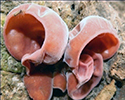
Edible macrofungi of Kaliabar sub-division of Nagaon district, Assam, India.
Abstract
The investigation encompasses the study of macro fungi collected from rural areas inhabited by tribal people particularly in the fringe area of forest of Kaliabar Sub-division of Nagaon District, Assam (India). Some wood inhabiting macro fungi which were found to be edible and generally used by ethnic tribes of Kaliabar sub-division were observed. A total of 14 species belonging to 9 families were recorded.
Keywords
Full Text:
PDFReferences
Adhikari, M. K. Mushrooms of Nepal. P. U. Printers, Kathmandu, Nepal. (2000) ,pp.1-236
Adhikari, M. K. Mushroom poisoning and its state in Nepal. In Plant Resources Bulletin Depertment of Plant Resources Kathmandu, Nepal, No. 25 (2004), pp.56-58.
Alector, V. A., Compositional studies on Edible Tropical species of Mushroom. Food Chem., (1995) 54:256-268.
Alexopoulos, C.J. and C.W. Mims, Introductory Mycology John Wiley & Sons. New York (1979).
Arora, D. Mushroom Demystified; A Comprehensive guide to the fleshy fungi. Berkeley; Ten Speed Press. Canada (1986).
Bacon, J, Identificaton Guide to Mushrooms of Britain and Northern Europe. John Beafoy Publishing London. (2012) pp 1-160.
Bandoni, A.A., R.J.Bandoni, T.W. Flegel, Preliminary Pictorial and synoptic key of Thai fungi Bangkok; Mahidol University. Thailand (1996).
Boyce, J. S. and B. K.Bakshi, Drying of Sal. Indian For. 85(1959), pp. 585-588.
Chang, S. T., J. A. Bushwell and P. G. Miles, Genetics and of Edible mushroom in (Eds.). Gordon and Branch, Philadelphia, P. A. (1993).
Chowdhury, S., Some Fungi from Assam – Ind. Jour. Agric. Sci., (1944), 14, pp230-233.
Ellis, M.B and J.P. Ellis, Fungi without gills (Hymenomycetes and Gasteromycetes) Chapman and Hall. London, (1990).
Else, H. and H. Hvass, Mushrooms and Toadstools. Blandford Press Pode Dorset (1979), pp. 1-156.
Gilbertson, R.L, Wood rotting fungi in North America. Mycologia 72 (1980).
Jennison, M. W., M. D. Newcomb and R. Henderson, Physiology of wood rotting Basidiomycetes, Growth and nutrition in submerged culture in synthetic media. Mycologia, 47 (1955), pp. 275-304.
Jonathan, S.G and I. O. Fasidi, Antimicrobial activities of two Nigerian edible macro-fungi Lycoperdon pusilum (Bat. Ex) and L. giganteum. (Pers). African J. Biomed Res. (2003).
Largent, D.L., How to identify mushrooms up to genus Macroscopical Features, (1977), pp.1-85.
Mueller, G. M. and G.F. Bills., Biodiversity of Fungi. Inventory and monitoring Methods. Elsevier Inc. (2004) pp.49-58.
Okwulehie, I. C. and E. I. Odunze, Evaluation of the Nutritional value of some Tropical Edible Mushrooms. J. Sustainable Agric. Environ, 6, (2004), pp.157-162.
Overholts, L.O., The Polyporaceae of the United States, Alaska and Canada, Univ. of Missigan Press. Ann. Arbor. (1967) pp.1-466.
Philip, R.., Mushrooms of North America. Little Brown and Co., Boston (1991).
Rambelli, A. and U. G. Menini, Manual on Mushroom Cultivation. Food and Agricultural Organisation of the United Nations, Rome, Italy, (1983), pp. 68.
Roy, A.K., Occurrence of Polyporus comerarius in Assam. Sci. and Cult. 31(1965), pp. 113-312.
Sarma, T. C.; I. Sarma and B. N. Patiri, Wild Edible Mushrooms used by some Ethnic Tribes of Western Assam. The Bioscan; Special issue 3, (2010), pp.613-625.
Shigo, A.L., Successions of organisms in discoloration and decay of wood. Int. Rev. Forest. Res. 2(1967), pp.237-239.
Yongabi, K.; M. Aghu D. and Martinez-Carrera, Enthnomycological studies on wild Mushrooms in Cameroon, Central Africa, Micologia Aplicada International, 16.2, (2004), pp 34-36.
Zoberi, M.H., Tropical Macrofungi. MacMillan Press Ltd, (1972), pp 1-157.
DOI: https://doi.org/10.21746/aps.2018.7.3.12
Copyright (c) 2018 Annals of Plant Sciences

This work is licensed under a Creative Commons Attribution-NonCommercial-NoDerivatives 4.0 International License.


